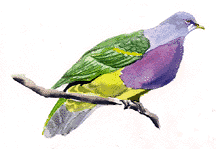


(Megaloprepia magnifica)
Pigeons and doves are of the order Columbiformes and the family Columbidae. They are found throughout the tropical and temperate zones. There are 290 species, including the doves.
Their long wings and powerful flight muscles make them strong, swift flyers. They are small headed, short-legged, swift-flying birds with pointed wings and fanned or tapered tails. Females are duller than males.
All species coo; bob heads when walking. Pigeons are monogamous; which means they mate for life. If one bird dies, the survivor accepts a new mate slowly.
Pigeons eat grains, small seeds, acorns and fruit. Nests are generally in trees; eggs, usually 2, are white. The female generally incubates by night, the male by day. The incubation period is 14 to 19 days and the young are cared for in the nest for another 12 to 18 days.
The fruit pigeons (14 inches) of the Polynesian islands (genus Ptilinopus) are brightly colored tropical forest dwellers. The top of the head is often violet, and the rest of the color pattern consists of softly blended pastel shades of green, yellow and lavender. They feed on fruits and berries, rarely coming to the ground.



